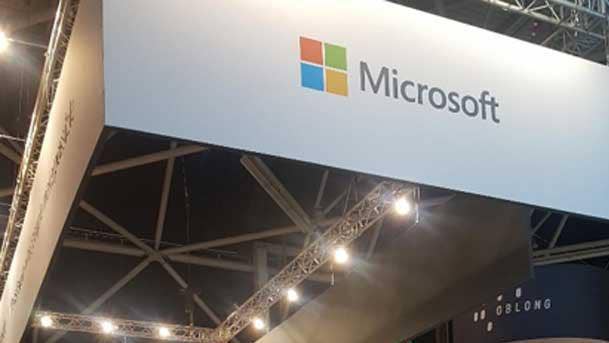Microsoft’s Erik Arnold: Why Now’s The Time To Tap Into The ‘Partner Momentum’ Around Nonprofits
‘A lot of [nonprofit] organizations have their own custom workflows or things they want to do, and it‘s available for partners to take and extend and add different functionality to tune it for a specific organization. So it lights up our SIs, it lights up our ISVs. We’re seeing partners that have been traditionally associated with other platforms are now coming over to the Microsoft platform,’ says Erik Arnold, CTO for Microsoft’s Tech for Social Impact group.

For Microsoft partners, targeting nonprofit customers might not immediately sound as commercially appealing as those in manufacturing, retail, financial services and health care.
But all five fields are part of the tech giant’s “industry clouds” strategy. As part of that strategy, the company has rolled out Microsoft Cloud for Nonprofit and associated cloud-based nonprofit tools, which help partners leverage the opportunities these organizations provide. Partners, however, need to have a better understanding of nonprofit budget cycles, needs and pain points.
So says Erik Arnold, chief technology officer for Microsoft’s Tech for Social Impact group, who spoke recently with CRN about the tech giant’s investments in cloud tools aimed at nonprofits and what partners can do to add or grow nonprofits as a line of revenue.
“There is so much white space in this area because it has been so underserved,” Arnold said. “There is a lot of creativity and innovation possible for organizations to lean in. And that‘s where others have opportunity.”
Nyasha Tunduwani, founder of Seattle-based Microsoft partner Real Impact Technology Consulting, told CRN that his company has worked with nonprofits since around 2007, starting with the Head Start organization working on AIDS awareness campaigns.
“It’s a solid opportunity. It’s a good revenue opportunity,” Tunduwani said. “I like to say that the difference with nonprofits is the clients say, ‘Thank you.’ For a lot of them, it’s the first time that they’ve been treated well by a partner.”
Lately, his nonprofit customers have requested more tools around cybersecurity and proving through data that programs delivered positive outcomes in a community. Microsoft Teams voice tools and Azure migration assessments have also proven popular. Nonprofits, with outdated software and IT systems are fertile ground for new business. “They [nonprofit leaders] may not know how to do it, but they understand that manual processes hold back their ability to serve more people,” he said.
Here’s what else Arnold told CRN about the partner opportunity with Cloud for Nonprofit.

What do channel partners need to know about Microsoft’s investments in targeting nonprofits as cloud customers?
I‘ll start that answer by talking a little bit about the business model that we have within Microsoft that was the genesis for all of this. So Microsoft, we’re a very philanthropic organization, it’s part of our DNA, has been for 40 years.
What we didn‘t do well is actually work with the nonprofit sector like an industry, like any of our other priority industries. So it was really uneven if you were a nonprofit. Maybe you got an education discount. Maybe you got a government discount. Maybe you’re paying the street rate. Maybe you knew someone at Microsoft and you got a donation. It was all over the place.
So we feel a responsibility as Microsoft to do more and to engage more on societal issues and see what we can do to help move the needle on social impact. And to be able to do that as a shareholder-owned organization, we needed to create a sustainable business model inside the company to run that. So we created a team called Tech for Social Impact.
We sit inside Microsoft Philanthropies, but you can think about us as a siloed industry team. We have dedicated account staff. We have dedicated technical design staff. We have customer support and customer success staff. We‘ve got engineering, marketing, partner, all focused on nonprofit.
And what this has allowed us to do is build affordable technology and solutions. I lead engineering and lead some of our philanthropy programs as well. The Microsoft Cloud for Nonprofit is a specific, first-party Microsoft product we‘re delivering. All of that is built on an architecture that we’ve been delivering over the past three years specifically targeted at our partners.
We also are able to reinvest everything that we work with with our nonprofit clients back into the business and so we net out at zero every year, and that has allowed us to scale the number of nonprofits that we work with. From the first year—70,000 nonprofits—to this year, about 240,000.
The only way we can do that is with partners. And one of the things that we‘ve seen in working with our partner community is the business model that we’ve been able to create. We’re doing well by doing good. And so we’re able to take this model and talk to other partners about the sector.
The nonprofit sector is the third largest industry in the U.S. It employs over 20 million people. And it is traditionally underserved. There‘s a lot of white space. There is a lot of desire among nonprofits to modernize their technology and work with partners, with technology companies to help them get there, to use modern technology in the course of their operations and run more efficiently and in the course of their mission and drive more impact.
We work directly through our network of hundreds of thousands of nonprofits. We work with that network to identify and document best practices and reflect those best practices into a data schema that addresses all the things that are unique to the nonprofit sector. They‘ve been underserved, great. What is unique about that industry that we can reflect in a data architecture and relationships between data entities that then represent a common data model reflective of those best practices? That immediately takes R&D out of the equation for any partner looking to implement into a nonprofit. You already have the schema built based on how … fundraising or program delivery or impact measurement should happen.
We developed that common data model in 2017. We published it in 2018. We‘ve been iterating on it every year since, very closely tied with that client steering team of nonprofits, institutional donors and private foundations that all participated with us in creating that. We publish that open-sourced to GitHub, available for any partner, not even Microsoft partners. We want it to be interoperable across multiple different platforms. And we’ve had good success. Partners across different platforms have adopted it or aligned to it—Unit4, Fluxx and others. NeonCRM recently announced that they’re aligning to it, along with dozens of Microsoft partners that are taking that architecture and building on it and creating new innovations that are representative of core capabilities and scenarios in the nonprofit sector.
It is slow to sell into the nonprofit sector, and the margins are tight. Naturally they want to have as much money as possible going toward the mission. And we weren‘t seeing some of the innovation as fast as we wanted to see from partners. And with the broader Microsoft strategy around our industry plays in health [care] and retail and others, we felt we should also go that far with nonprofit and take that extra step so that we get from that 60 percent accelerator data schema to now finished applications in core areas.
Nonprofits very widely. We work with everything from Little League teams to large research institutes to zoos to UNHCR [the United Nations High Commissioner for Refugees], which works with 60 million refugees. And what‘s common among all of those organizations is fundraising, working with beneficiaries, working with constituents, program delivery, delivering services to beneficiaries. … Being able to measure that impact, being able to aggregate all of that data and tell the story back to the donor, to trace the donation all the way through down to the service delivery and tell that great impact story back to the donor and create that flywheel that keeps these organizations going.
And then they‘re also businesses. There is some uniqueness around operations and financials in terms of calculating overhead rate and other areas where we can build into. And so we picked a few of those and that’s what Microsoft Cloud for Nonprofit is.
The way we do it is we make sure it‘s very, very modular. There is so much white space in this sector. It allows us to create a finished product like Fundraising and Engagement, which is a fundraising and constituent management tool.
And if you are a nonprofit and want to take it and pick it up and implement it, you can, it‘s a finished app. A lot of organizations have their own custom workflows or things they want to do, and it’s available for partners to take and extend and add different functionality to tune it for a specific organization. So it lights up our SIs, it lights up our ISVs. We’re seeing partners that have been traditionally associated with other platforms are now coming over to the Microsoft platform. We’re starting to see startups that are beginning that are taking this architecture and specifically building businesses around nonprofit and the Microsoft technology side. So it’s been really exciting and satisfying to see the partner momentum.

What’s led to this period of nonprofits as interesting customer targets?
It‘s a variety of things. A little bit about my background as I answer that question—over 25 years, a whole bunch of different technology roles, cut my teeth in a privately held Bill Gates organization, but then I spent 10 years in the nonprofit sector as a CIO so I’ve walked more than a mile in the shoes of the clients we’re trying to reach.
So a few things are happening here. One is for decades and decades, the easy measure that many donors used to look at the efficacy of a nonprofit organization was overhead rate. How much of any given dollar donated to a nonprofit goes toward mission? How much of that goes toward administration? And the belief was that the less you have going toward administration— how you run your business—the better, more impactful you‘re going to be.
Turns out, you build a really inefficient organization over the years if you don‘t invest in yourself, so that worked against many nonprofit organizations for decades. And that really led to this underinvested, underserved environment that we’re in now.
Roughly five years ago, some of the bigger institutional donors changed their rules that allow for depreciation of capital investments. They made it a little bit easier to make significant investments in digital technology. And there was a movement by donors toward having more data-driven decisions and investments and wanting to see nonprofit organizations use data in more strategic ways. That required donors to invest more in technology. Now there‘s a shift in donors wanting nonprofits to be sophisticated with data, realizing, ‘Oh, we actually have to fund the technology data-gathering.’
That led to some organizations like Microsoft and Tableau and others to really lean into the nonprofit sector from that data lens, working with organizations that were building data collection tools. That led to organizations building digital skills and thinking about digital a little bit better. It‘s been a little bit slow, but we’re at an inflection point right now where there’s a lot more awareness among nonprofits. It’s a little bit easier from how you actually structure projects like this. Donors are asking for it and, in some cases, helping to pay for it.

What’s the advice to Microsoft channel partners wanting to start a nonprofit vertical or invest more in their existing one? And what’s the pitch to consider nonprofits?
Do well by doing good. And you need to make sure you‘re engaging the nonprofit sector in the right way and not overly selling to nonprofits and make sure you spend the time to understand the mission and things like that.
That aside, there is so much white space in this area because it has been so underserved. There is a lot of creativity and innovation possible for organizations to lean in. And that‘s where others have opportunity. Small ISVs and startups like Mission CRM are lighting up. Traditional Microsoft partners like Avanade and others are starting nonprofit practices.
Because we‘ve invested a few years in identifying those best practices—reflecting those best practices in a data schema, getting sector buy-in around that, broadly, as an interoperability play, that there’s a movement across a number of different technology organizations that are adopting this underlying tech and then building more finished solutions on top of it—we just took a whole bunch of cost out of the equation for some of these partners.
If you‘re an SI, we have finished solutions. You can take these solutions and build a standard deployment menu. You can build professional services around it for organizations that want to take it and customize it for their own needs.
If you‘re an ISV, you have a great place to start with a standard model that organizations are starting to snap to and align to. You’ve got finished applications that you can take. You don’t have to create your own fundraising tool. You can take ours and extend it for whatever need, in a specific geography or a specific sub-vertical, should you choose.
There is recognition that the margins are so tight by Microsoft making the investment through our sustainable business model. We‘re then making it easier and easier for our partners to lean in to the sector. Even if they’re new to the sector, they’ve got a great place to start.

What new integrations and investments in products and services should Microsoft channel partners look forward to if they have a nonprofit specialty?
Where we‘re focusing is helping organizations know their donors and their supporters, helping them deliver effective programming and then helping accelerate mission outcomes. Generally, that’s CRM. That’s a service delivery, and that’s data and analytics.
We spent a bunch of time identifying what the top scenarios and capabilities were. And then we build into each of these. The first tranche of work that we did around the common data model, these are the capabilities that we lit up with the common data model.
Then we built accelerators, sample applications on top of that. Then we built Fundraising and Engagement. That was our first first-party tool. And then Microsoft Cloud for Nonprofit starts to light up insights and impact, and volunteer management and volunteer engagement.
What we just launched was integration with LinkedIn. The area we‘ve addressed really well right now is constituent management and donation and award management and that nice integration with LinkedIn. Where we’re going next in private preview right now, going into public preview this summer and GA [general availability] in the fall, is Volunteer Management.
That is how organizations that use volunteers, how can they create volunteer opportunities, how can they set up schedules, how can they identify skills needed for specific volunteer opportunities, assign it to a specific geography, and then create ways for volunteers to engage with the organization, to find those opportunities, to find other volunteers to on board, to certify that they have the skills. That‘s coming next.
You‘ll see us then build more into program deliveries that design, deliver and measure, that unify data bringing the operational data together with the program data. And then, how do you tell that story really well through marketing to your donors. And then through things like customer insight, get really personalized engagement and [an] understanding [of] how your donors are giving, what are they responding to, and then providing them that information that then gets back into the constituent management, completing the circle.
[Grant writing is in here] from a data model perspective. What we have done as Microsoft is we‘re focusing on the nonprofits. From the foundation side, those organizations that are providing grants, we have partners like Avanade, which has released a grant management application. And we’ve got some others as well. That’s an area where—I was talking about white space—great, we’re not going to go after it as Microsoft and our partners have the opportunity.

This is an opportunity for the midsize and smaller nonprofits, not just the largest organizations, correct?
With the 4 million nonprofits and around the world, in 3.9999 million of them there are less than 50 people. There are nonprofits that are 50,000 people operating in 100 countries and are as complex as any of the complex conglomerates that you can think of. And there are five-people food banks and organizations that are dealing with homelessness or drug addiction, these health and human services organizations that are working in municipalities and urban areas.
We want to maximize the offers or donations, the technology for that long tail. Those are the organizations that really can‘t afford to take and configure a complex system. They need more turnkey solutions. Us investing in this architecture and this baseline technology, we make it easier for those ISVs and those partners that are serving that community.
This is a partner play for us as much as it is a nonprofit play. That‘s true across all the different industries that Microsoft is supporting—we’re one of the five priority ones right now.
We are also working very, very closely with our partners and we have partner advisory boards that we work with because if we go too far as Microsoft, if we cross the line, we‘re going to stifle innovation. So we have to walk a really fine line here in terms of the architecture products that we create and support that are taking that cost out of the equation, reinforcing best practices, encouraging innovation. And if we go too far, we are going to run afoul of partners.

Did the pandemic hurt donations and grants and other ways nonprofits raise money?
This perfect storm last year of COVID and economic instability hit right at the height of the refugee crisis, food insecurity. At the point where nonprofits are needed most—these are the organizations that are at the front lines of all those issues—a bunch of funding disappeared. In-person fundraising gone in a day.
All these organizations needed to shift to more modern ways, digital ways of doing fundraising. They all have to be digital; oftentimes that‘s the only way you can engage your donor.
The data that‘s coming out of the U.S. at the end of last year showed about a million people employed by nonprofits lost their jobs. About 7 percent of the nonprofits in the United States closed permanently. In the U.K., it’s a higher percentage. And the donations that are coming in are really uneven. If you look at the aggregate amount of donations that happened last year, it was actually up, but so much of it went to COVID. There are things like arts and culture organizations, like the zoos and museums, they closed. So they lost a bunch of funding.
Some parts of the sector are really struggling. And other parts of the sector are like, ‘We can‘t hire fast enough to address some of the issues.’ By and large, the sector got hit hard. And it is recovering, along with everyone else that’s recovering. But I expect it’s going to lag a little bit.

Sounds like there is a chance for channel partners to sell more products and services to nonprofits once a nonprofit customer is in the Microsoft ecosystem.
It is modular, so the volunteer management piece you can pick up and operate independently. The fundraising piece you can pick up and operate independently. We do all the work to make sure if you use both, they‘re going to be seamless.
We donate about $1 billion of cloud software every year to over 240,000 nonprofits around the planet. We have a standard discount across all of our premium products that we pass on through our partners. So if you‘re a qualified nonprofit, our technology is very affordable.
And we maximize our donations for those smaller organizations. We want to make sure nonprofits have the technology they need to operate, to be productive in a digital world, to have affordable access to modern tools and modern architecture. With being able to pass that through our partners, our partners now have the technology and they have the offers all put together for them that allow them to address this part of the business.
One of the first things that popped for Microsoft when we launched this industry strategy is, ‘Wow, look at all these cross-industry opportunities.’ Those health and human services organizations, they work with health-care providers. Health-care providers provide referrals to those organizations. Municipal or county or state governments provide funding into those organizations. So, think about a referral system or a case management system between those organizations. There‘s opportunity as a partner to think about, not just nonprofit in isolation, but nonprofit together with some of your other industries.

What needs to happen for more nonprofits to embrace cloud computing and cloud tools overall?
The biggest thing for me is digital skilling. I don‘t just think about the technology and the product side. We also think about all the capacity building that you need, all the skills that you need, all the skills, your beneficiaries maybe need to use modern digital tech. We don’t just invest in the product. We also invest in that side.
That‘s my role at Microsoft. I lead the engineering for the product, but I also lead our cloud donation strategy, our digital transformation services—where we donate digital transformation services to nonprofits to help them reimagine their mission and their operations using digital tech—and our digital skills for nonprofit employees where we provide training and certifications for the employees of nonprofits. Microsoft Philanthropies, we have a digital skilling program that is now over 30 million people over the last 12 months, we’ve trained to help them with participating in the digital economy and offering them some better economic opportunity and economic mobility.
Do you want to see more Microsoft channel partners adding nonprofit verticals to their customer base?
Always. We are a partner organization and partner-led. We‘re successful if our partners are successful. The more partners that are engaged in this sector, the happier we’re going to be.
As a sector that is underserved, with a lot of white space, the more partners that come into it, the more innovation we‘re going to see. This is the industry that’s out there trying to make an impact and do social good.